Sage Lace Curtains: Elegance for Modern Spaces
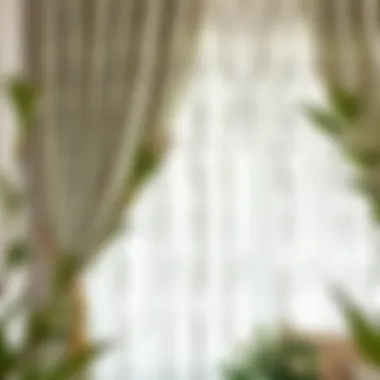
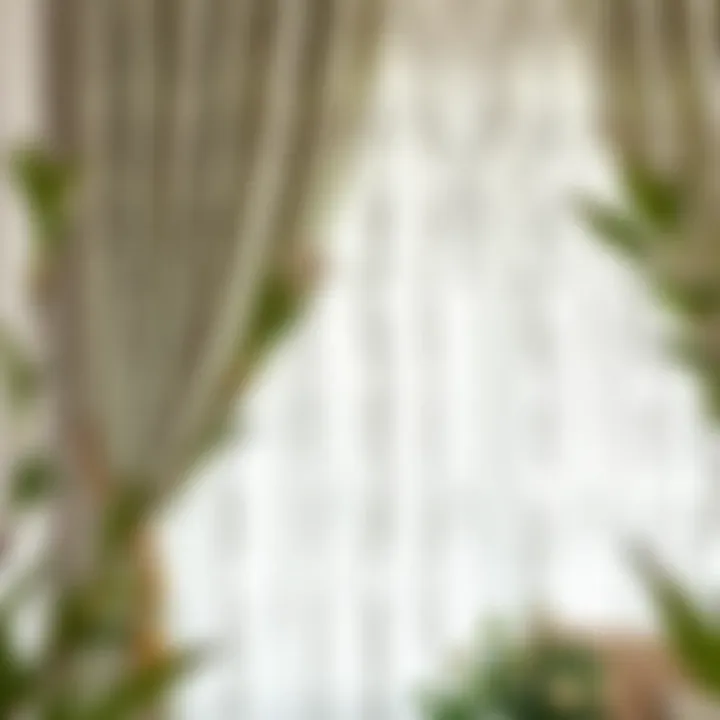
Intro
When discussing interior design, textiles often take center stage as the unsung heroes of aesthetics and functionality. Among these, sage lace curtains manage to balance the delicate touch of elegance with the sturdiness needed for today's homes. This article examines the multifaceted aspects of sage lace curtains, providing insights from their history and design potential to practical tips for maintenance and installation. The intention is to highlight the unique qualities that allow these curtains to enhance modern interiors, serving both utilitarian roles and decorative purposes.
In exploring sage lace curtains, we will uncover their historical roots and how cultural shifts have made them a staple in various home designs. We won’t shy away from discussing contemporary trends and practical applications either; after all, these insights can empower designers, retailers, homeowners, and DIY enthusiasts alike. Whether you’re looking to add a touch of class or simply strive for creative expression in your space, this guide aims to equip you with the knowledge needed to make informed choices.
Let’s delve into the design insights that can help establish a harmonious balance throughout your interiors.
The Historical Context of Lace Curtains
The lace curtain has become a staple in many homes today, but its history is as intricate as the fabric itself. Understanding the historical context of lace curtains not only adds depth to their aesthetic appeal, but also highlights their significance as a cultural symbol in various eras. This section aims to peel back the layers of time to reveal the roots of lace and how it transitioned into the modern home.
Early Origins of Lace
Lace is often said to have its beginnings in the 15th century, originating in the southern parts of Europe, possibly in Italy or France. Initially, lace was a luxury item, not easily accessible to the average person. It emerged from the intricate needlework techniques that women employed, often drawing upon religious inspirations and botanical designs.
Interestingly, early lace was often referred to as “point de France” or “punto in aria.” This exquisite form of craftsmanship required immense skill and patience. Women would spend countless hours creating delicate pieces, which were significant not just for their beauty, but also as indicators of wealth and status. Owning lace curtains in a home was akin to owning a piece of art that showcased one's social standing.
As demand for lace grew, various regions began to produce their unique styles. The Venetian lace, for example, became renowned for its intricate designs and fine craftsmanship. Each location developed local techniques, contributing to the diversity of lace curtains we see today.
Transition to Modern Usage
Fast forward a few centuries, and lace curtains found their way into everyday life, moving beyond the palaces and affluent households. The Industrial Revolution played a crucial role in this transformation. With the advent of mechanized production in the 19th century, lace became more widely available. Factories began mass-producing lace, making it accessible to the middle class. This democratization of lace meant that homes of varying economic statuses could enjoy the elegance and benefits of lace curtains.
The 20th century saw lace curtains evolve further, as they were incorporated into various design paradigms. From cozy country cottages to sleek urban apartments, lace became synonymous with soft, ethereal aesthetics. The charm of lace curtains now extended beyond mere decoration; they embodied a sense of home and warmth.
The modern-day interpretation of lace curtains still carries echoes of those early days. While there’s a wide variety of fabrics and styles available—from traditional cotton lace to polyester blends—they all share a common thread: the ability to transform a space, providing beauty while serving practical purposes.
Lace curtains have become modern classics that speak to our need for both beauty and utility.
Understanding the journey of lace curtains—from their luxurious origins to their practical applications today—enriches the appreciation for these elegant textiles. They are not just decorative pieces but also tell a story of craftsmanship, innovation, and the evolution of interior design.
Understanding Sage Color Psychology
The exploration of sage lace curtains goes beyond mere aesthetics; it dives into the underlying psychological effects of the color itself. Sage green, a hue that hovers between green and gray, carries significant weight in design and ambiance. Understanding the psychology of this color can enhance the overall appeal of a space, creating environments that feel soothing, harmonious, and inviting. Incorporating sage into your décor, especially through lace curtains, can evoke feelings of tranquility and balance, which is crucial in today’s often chaotic world.
The Symbolism of Sage Green
Sage green is often associated with renewal and growth. Its presence in nature as the color of sage leaves brings forth imagery of lush landscapes, fresh beginnings, and the essence of life itself. This color symbolizes:
- Calmness and Restorative Energy: Just as one would feel the gentle breeze of a late afternoon, sage green can supplant stress with serenity.
- Connection to Nature: Incorporating elements of the outdoors helps evoke a sense of groundedness in one's space.
- Balance and Stability: Sage carries a natural softness, contributing to a harmonious balance in design that avoids overwhelming the senses.
"Colors, especially in interior design, do more than beautify; they influence how we feel in a space. Sage green is a perfect example of a color that fosters comfort and calmness."
Effects on Interior Spaces
Incorporating sage lace curtains into your home is about more than just their visual appeal. The effects of sage green on interior spaces can create profound transformations:
- Light Reflection: Sage’s unique shade allows it to reflect light beautifully while still filtering it effectively. This creates a soft, inviting atmosphere that feels airy and expansive.
- Visual Continuity: The muted quality of sage fits seamlessly into various interior styles—be it a cozy cottage or a sleek modern loft. Its versatility means that it can complement many palettes, making it an excellent choice for lace curtains.
- Enhanced Spatial Perception: Sage green can also affect how space is perceived. Lighter greens can make small rooms appear larger, while deeper shades can add depth.
Design Versatility of Lace Curtains
The design versatility of lace curtains lies at the very heart of their charm. They possess an ability to seamlessly adapt to various interior styles, melding with both classic and modern environments. This adaptability makes them more than just a decorative element; they become integral to the overall aesthetic of a space. Lace curtains can soften harsh architectural lines, introduce a sense of elegance, and create enchanting atmospheres, all while allowing adequate light filtration. The inherent delicacy of lace, when combined with the sage color, offers an understated sophistication that appeals to a wide array of design sensibilities.
Complementing Various Decor Styles
Traditional Aesthetics
Traditional aesthetics often evoke feelings of nostalgia and comfort. With its rich textures and intricate patterns, a traditional lace curtain can bring a sense of history into a home. The soft, flowing nature of lace harmonizes beautifully with classic furniture pieces, enhancing their charm without overpowering them. One key characteristic of traditional lace curtains is their intricate design, which often includes floral motifs or elaborate borders. This quality makes them a popular choice for those seeking to create a timeless look in their living spaces.
A unique feature of traditional aesthetics is their ability to frame windows in a way that emphasizes the architecture of the house itself. The lace acts as a delicate boundary, softening sharp lines while maintaining a sense of connection to the outdoors. However, they may not be suitable for minimalistic styles, as they can create a feeling of clutter if not used thoughtfully.
Contemporary Interiors
Contemporary interiors lean towards functional elegance. The grace of lace curtains in this context is often appreciated for their ability to add texture without compromising on simplicity. A key characteristic of contemporary lace curtains is their clean lines and often simplified patterns. This makes them a beneficial choice for modern spaces where the focus is on creating harmony without excess.
In contemporary designs, sage lace curtains provide a subtle yet impactful statement. They can easily complement sleek furniture and minimalist décor. The unique feature here includes the use of sheer fabrics that allow light to filter through while maintaining a sense of privacy. On the downside, some may argue that lace lacks the strong visual impact of solid, heavy drapery.
Bohemian Influences
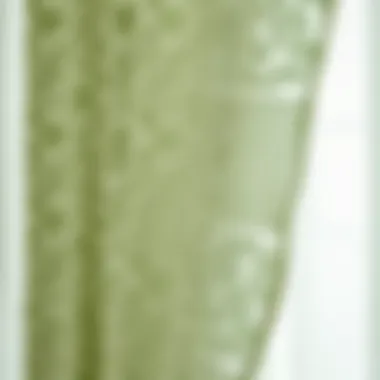
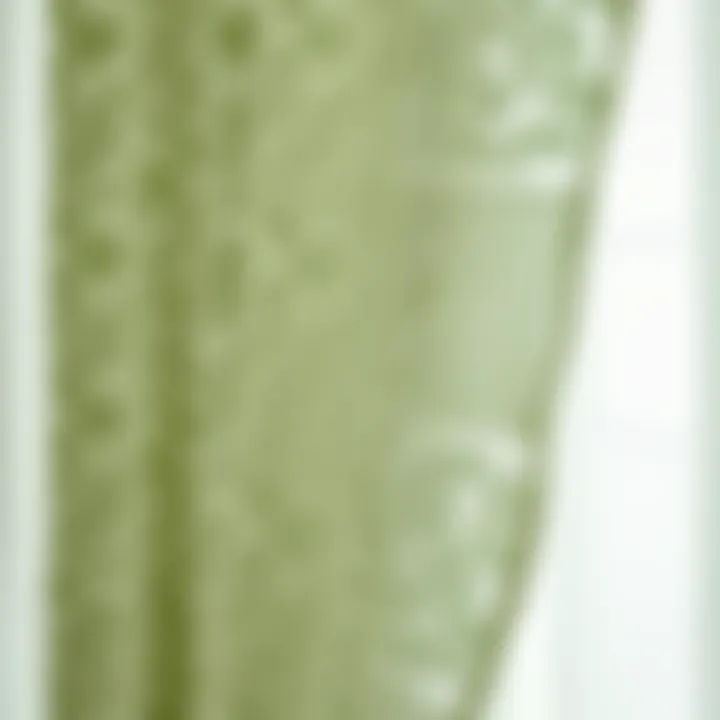
Bohemian influences thrive on mixing and matching, bringing eclectic styles into a single space. Lace curtains in sage can add an ethereal touch to a room filled with vibrant patterns and textures. The key characteristic is their free-spirited vibe, making them an excellent choice for those looking to create relaxed, inviting environments.
A defining trait of Bohemian-style interiors is their embrace of individuality, where every piece tells a story. The unique feature of using sage lace in this context is that it can soften bold decor, creating a whimsical yet cohesive atmosphere. This flexibility might bring disadvantages if the colors and patterns do not align; too much variety can easily overwhelm the senses.
Layering Techniques
Pairing with Solid Fabrics
Pairing sage lace curtains with solid fabrics is a savvy trick used by many designers to create depth and interest in any space. This technique allows for the lace to shine through while the solid fabric provides a complementary backdrop. A key characteristic of this pairing is the contrast of textures—smooth solid fabrics juxtaposed against the delicate lace create a visually appealing dynamic. This combination fosters a cozy yet sophisticated environment, making it a popular choice in both residential and commercial settings.
The unique advantage here is that it allows for personalization; homeowners can select solid fabrics in shades that either match or contrast with the lace, crafting a tailored look that reflects personal style. However, one must be cautious not to overwhelm a space with too many patterns; keeping the balance is essential.
Using Underlays for Texture
Using underlays as an additional layer beneath lace curtains can elevate the overall design and add a luxurious feel. This technique involves placing a solid fabric or a patterned underlay behind the lace curtain to enhance both visual interest and texture. The key characteristic of this practice lies in its ability to amplify richness in the fabric ensemble. This is especially beneficial for those looking to add warmth to spaces often afflicted by cold, harsh lighting.
A distinctive advantage of using underlays is the option to play with color palettes while introducing an element of surprise with an unexpected underneath. It opens the door to creativity, allowing for a mix-and-match approach while ensuring that the lace curtain remains the star of the show. Nonetheless, caution is advised, as using too many layers may overcrowd a window treatment, leading to a cluttered visual presentation.
Materials and Weaves of Sage Lace Curtains
The materials and weaves play a significant role in defining the aesthetics and functionality of sage lace curtains. Understanding these aspects can help designers, retailers, homeowners, and DIY enthusiasts make informed choices when selecting curtains that not only elevate the beauty of their spaces but also meet practical needs. Proper selection and knowledge of materials enhance the overall appeal while ensuring durability and ease of maintenance.
Common Fabrics Used
Cotton Lace
When it comes to lace curtains, cotton lace stands out for its breathability and natural feel. This fabric is classic and carries an air of elegance, effortlessly tying together traditional and contemporary décors. One key characteristic of cotton lace is its ability to absorb moisture, which helps in maintaining a comfortable environment in homes.
This fabric often features intricate patterns which can embellish a room without overwhelming it. An advantage of cotton lace is its washability, making it a practical choice for everyday use. However, it can be a bit more prone to wrinkling, requiring regular maintenance. Despite this, many homeowners appreciate the added charm that cotton lace provides, making it a popular choice for those looking to balance style with functionality.
Polyester Blends
Polyester blends have gained traction in recent years due to their durability and resistance to wear and tear. Blending polyester with other materials creates a fabric that maintains the delicate look of lace without the susceptibility to fading or fraying. This characteristic makes polyester blends a smart choice for households that experience higher foot traffic or have pets.
The unique strength of polyester lace allows it to hold up well against the sun's rays without easily discoloring. On the downside, polyester may not be as breathable as natural fibers like cotton. For some, that can be a disadvantage, especially in warmer climates. Nonetheless, its low maintenance and sturdiness make it appealing for those seeking elegant but long-lasting solutions.
Sheer Fabrics
Sheer fabrics take light filtering to a new level, providing homeowners with a soft glow while maintaining a semblance of privacy. The delicate nature of sheer fabrics invites an ethereal quality into any space, which complements sage green tones beautifully. One major plus is the amount of light these curtains allow into your home, creating an inviting ambiance.
The airy feel of sheer fabrics can enhance a minimalist or modern aesthetic wonderfully; however, they may not offer enough coverage for those seeking complete privacy. They are often used in combination with heavier drapes, allowing for dynamic layering that can help achieve both style and function. With sheer lace curtains, it's all about balance, utilizing their strength to accentuate the beauty in a room.
Understanding Weave Patterns
Weave patterns greatly influence the texture and look of lace curtains. The intricacy of the weaving can define the overall feel of the fabric, determining whether a curtain feels modern, classical, or something in between. Varieties like embroidered lace or floral lace can add personality to your space, making lace curtains not just a functional addition but a statement piece.
Different patterns will also affect how light interacts with the fabric. For instance, loose weaves might let in more light, creating an airy atmosphere, while tighter weaves offer a more structured appearance.
Selecting the right fabric and weave is essential for building a cohesive aesthetic in your home while ensuring curtains remain practical and enduring. Understanding these materials goes hand in hand with the elegance that sage lace curtains promise to bring into your living spaces.
Functional Benefits of Lace Curtains
Lace curtains serve more than just an aesthetic appeal in the realm of interior design; they provide a multitude of functional benefits that enhance home environments. Understanding these benefits is crucial for designers, retailers, homeowners, and DIYers alike as they consider incorporating these elegant textiles into their spaces. From their ability to filter natural light beautifully to offering a degree of privacy, sage lace curtains boast practicality alongside grace.
Light Filtering Properties
The capacity of lace curtains to filter light stands out as one of their most remarkable features. Unlike heavy drapery, lace does not block out sunlight entirely; instead, it gently diffuses it, creating a soft, warm glow throughout the room. This light filtering quality can transform a stark, sterile environment into a serene sanctuary.
With sage lace curtains, the color plays a pivotal role. The subtle green hue can have a calming effect, making spaces feel more inviting. It’s a delicate balance; enough light enters to enliven the space without overwhelming it. Moreover, with their airy fabric, lace curtains can make small rooms feel larger by allowing light to penetrate while also providing a level of softness that helps in sound absorption.
Some key advantages of light filtering properties include:
- Mood Enhancement: The right light levels can drastically change one's mood, making the environment feel more comfortable.
- Energy Efficiency: By diffusing light, lace curtains can help maintain an even temperature, possibly reducing the need for artificial lighting and heating.
- Visual Appeal: Depending on the weave, lace can create interesting shadows and patterns on walls and furniture, adding dynamic visual interest.
Privacy Considerations
While lace curtains offer ethereal beauty and light control, they are also an effective way to maintain privacy. In densely populated areas where homes are close together, having a sheer fabric can provide a buffer. Sage lace curtains allow homeowners to enjoy unobstructed views of the outside while ensuring that people on the street cannot see in clearly.
That said, it’s essential to understand that sheer materials differ in their privacy levels based on time of day and lighting conditions. During daylight hours, lace can provide a greater sense of security; however, at night, one might need to consider layering with heavier curtains or blinds to ensure complete privacy.
Here’s why privacy is paramount in interior design:


- Comfort: Feeling secure in one's home contributes to a sense of overall well-being.
- Aesthetic Balance: Lace curtains combined with other textile layers can create a balanced visual dynamic, allowing flexibility while catering to both needs of light and seclusion.
- Design Harmony: Introducing curtains that elegantly filter both light and prying eyes aligns with modern tendencies toward minimalism and tranquility in home design.
"The perfect window treatment strikes a balance between visibility and seclusion, creating a serene sanctuary for any home."
In summation, lace curtains—especially in the refreshing color of sage—serve dual roles: they provide functional benefits in terms of light filtration and privacy while enhancing the beauty of any living space. Integrating these elements thoughtfully can yield rewarding results in interior design.
Installation Tips for Lace Curtains
Installing lace curtains might seem like an afterthought, yet it's a pivotal step in achieving the desired aesthetic and functionality of your home. Proper installation can accentuate the elegance of sage lace curtains, ensuring they not only look good but also perform well in filtering light and providing privacy. Understanding the nuances in measuring, sizing, and the hanging methods available can transform your space into one that feels thoughtfully curated.
Measuring and Sizing
Measuring for lace curtains is crucial, as improper sizing can lead to unsightly gaps or excessive fabric bunching. Here’s how to get it right:
- Measure Window Width: Take the width of your window frame, making sure to measure at three different points—top, middle, and bottom. Use the widest measurement as your guide.
- Determine the Length: Decide where you want your curtains to fall—just above the floor, touching the floor, or pooling a bit. Consider the length of your curtain rod and the style you're aiming for when making this decision.
- Add Extra for Fullness: Lace curtains often look best when gathered or pleated, so add extra width—typically 1.5 to 2 times the width of your window—for a fuller appearance.
By investing time in getting these measurements right, you set yourself up for a successful installation that enhances the overall charm of your sage lace curtains.
Hanging Methods
The choice of hanging methods can greatly impact the appearance of your lace curtains. Below we discuss two popular options: rod pocket and clip rings, each having its unique traits that can sway your decision depending on style and functionality.
Rod Pocket
The rod pocket style is a classic and straightforward method to hang curtains. With this technique, the upper portion of the lace fabric has a sewn-in pocket where a curtain rod slips through. This method contributes to the elegant drape of the fabric while allowing for easy opening and closing of the curtains.
One key characteristic of the rod pocket is its ability to create soft, natural folds that complement the intricate patterns of lace. This method tends to be a widely popular choice due to its minimalistic design, fitting seamlessly into various interior styles, from traditional to contemporary.
However, it can have some disadvantages. Because the rod pocket may slightly restrict the curtains' movement, you may find that they do not glide as smoothly as desired. Nonetheless, its charming aesthetic typically outweighs these concerns for many homeowners.
Clip Rings
On the other hand, clip rings are a modern and stylish option for hanging lace curtains. Each ring is designed with a clip that attaches to the top edge of the curtain, allowing the fabric to hang freely and elegantly on the rod. This method is particularly beneficial for those seeking ease of movement; clip rings enable the curtains to slide along the rod with little friction.
A key feature of clip rings is their versatility. They come in various finishes, allowing you to match them with the metal elements in your room, whether it's brushed nickel or old brass. This makes them an appealing choice for a cohesive and polished look overall.
The only downside might be that some might find them slightly less traditional than the rod pocket, but their practicality and contemporary flair make them a strong contender for modern designs.
"The right installation technique not only enhances appearance but also the longevity and functionality of lace curtains."
In summary, whether you opt for rod pockets or clip rings, ensuring that your installation is precise can make all the difference in achieving the refined touch that sage lace curtains bring to your interiors.
Maintaining Sage Lace Curtains
Keeping your sage lace curtains in tip-top shape is not just about aesthetics; it’s about preserving their integrity and ensuring they continue to bring charm to your space. Lace curtains, while delicate and refined, also require a certain level of care. Proper maintenance enhances their beauty and extends their life, making your investment worthwhile.
Washing Recommendations
Washing lace curtains isn’t a simple task, but doing it right can make a world of difference. Here are some pointers to keep in mind for washing sage lace that will help keep those lovely drapes looking fresh:
- Check the Care Label: Always start by looking for specific instructions from the manufacturer. This could save you from any mishaps.
- Hand Wash with Care: If you choose to hand wash your curtains, it’s wise to use cold water and a mild detergent. Soak them gently and avoid wringing, which could stretch the fabric. Instead, let them soak in the rinse water for a while, then lift them out carefully.
- Machine Wash Cautiously: For those who prefer a washing machine, place your curtains in a mesh laundry bag. Use the delicate cycle with cold water and mild detergent to minimize agitation.
- Air Dry: It’s advisable to air dry lace curtains. Hang them up to dry naturally. Direct sunlight might fade the beautiful sage color, so find a shaded spot.
- Ironing Tips: If you need to iron your curtains, ensure they’re damp and set the iron to a low temperature. Use a pressing cloth to avoid direct heat.
Taking the time to properly clean your lace curtains not only maintains their beauty but also contributes to a healthier living environment by removing dust and allergens.
Preventing Wear and Tear
Lace curtains often face the brunt of daily wear and tear, especially in lively households. Here are some strategies to help preserve their charm:
- Limit Sun Exposure: Sage lace curtains, while beautiful, can fade if exposed to too much sunlight. Consider using backing or layering techniques to minimize sun exposure.
- Use Curtain Weights: Adding weights at the bottom of the curtains can prevent them from swaying excessively in the draft, which reduces wear.
- Handle with Care: When opening or closing your curtains, be gentle. Tugging on them can cause them to fray or tear. A light touch goes a long way.
- Regular Dusting: Occasional light dusting with a soft cloth or feather duster can prevent dirt buildup and keep the fabric looking fresh.
- Keep Away from Pets: If you have furry friends, consider training them to stay away from the curtains. Tugging and scratching can cause significant damage, leading to a need for replacement sooner than anticipated.
By implementing these simple yet effective strategies, you can enjoy your sage lace curtains for years to come, maintaining both their elegance and functionality.
Remember: A well-maintained curtain not only enhances your home but also reflects your attention to detail and care for your living space.
Sourcing Quality Lace Curtains
Finding the right lace curtains can feel like hunting for a needle in a haystack, especially with so many options available today. Sourcing quality lace curtains is not just about aesthetics but also about ensuring functionality and longevity. Good curtains can transform a room, while poor-quality ones can lead to frustration down the road. This section aims to guide you through the important factors to consider and where to find lace curtains that meet high standards.
Where to Buy
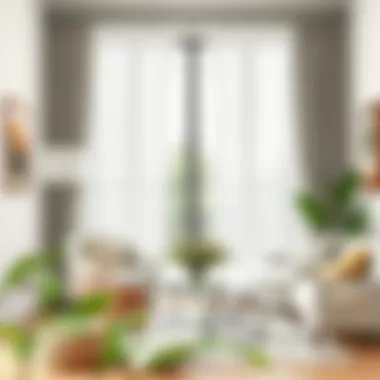
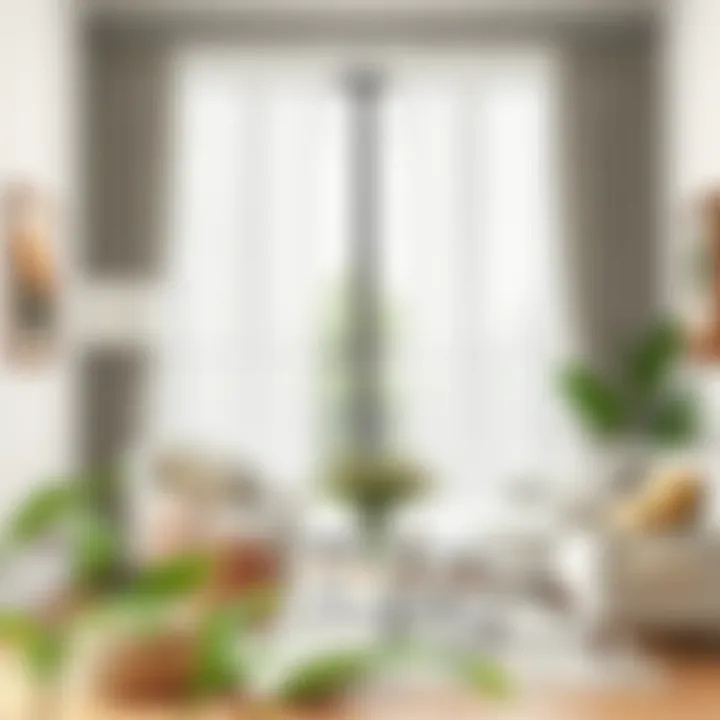
Online Retailers
Buying lace curtains online can open a treasure trove of choices. Websites like Amazon and Wayfair showcase vast selections of sage lace curtains, often including customer reviews. This is a major advantage, as reviews provide insights into the fabric quality and customer satisfaction.
One striking aspect of online shopping is the convenience it offers. You can browse thousands of options from your couch, compare prices, and make informed decisions without the pressure of salespeople. Another perk includes the ease of finding niche retailers who specialize in certain styles that may not be available in brick-and-mortar stores, like vintage or handcrafted lace curtains.
However, there are downsides. The primary concern is the inability to feel the fabric before purchasing. It can be tricky to determine how a curtain will actually look and feel in your space based solely on an image. Returns can be more tedious than simply dashing to a local store, leading to potential added hassle.
Local Boutiques
Visiting local boutiques for lace curtains can offer a completely different experience. These shops often carry unique, curated selections that reflect the character and style of the community. One major advantage of shopping in person is the chance to see and touch the fabric. This allows you to gauge the quality and how well it drapes before making a commitment.
Local shops often emphasize customer service as well, providing personalized recommendations and sometimes even custom options that larger retailers cannot offer. There’s a charm in discovering lace curtains that have a story behind them, whether they’re sourced from local artisans or inherited design traditions.
On the flip side, the selection might be more limited compared to online retailers. Depending on where you are, local boutiques might also come with a heftier price tag, reflecting their unique inventory and the artisanal craft that goes into their offerings.
Evaluating Quality
When it comes to lace curtains, not all products are created equal. Evaluating quality requires attention to several vital aspects. Look for well-constructed seams and a consistent weave pattern. High-quality lace curtains should have a balanced weight, ensuring they hang nicely without looking flimsy.
"Quality in materials in lace curtains not only enhances their beauty; it ensures durability and performance over time."
Consider the following tips for evaluating lace curtains:
- Fabric Type: Natural fibers like cotton or linen tend to offer a more luxurious feel than polyester blends.
- Dye Quality: Check if the color remains consistent and vibrant; well-dyed fabrics should avoid fading easily.
- Stitching: Inspect seams for sturdy stitching that can withstand regular use.
- Transparency: Assess how much light filters through the fabric to ensure it aligns with your privacy and lighting goals.
In summary, sourcing quality lace curtains involves a blend of knowing where to look and how to evaluate what you find. Whether you choose the convenience of online retailers or the charm of local boutiques, being informed will set you up for success in enhancing your spaces with beautiful sage lace curtains.
Emerging Trends in Window Treatments
As the design landscape continuously evolves, so does the realm of window treatments. Today, homeowners, designers, and retailers are keen to stay ahead of the curve by embracing emerging trends that cater not only to aesthetic desires but also to practical needs. The importance of this topic lies in understanding how these trends can be integrated into various home environments, enhancing both the beauty and functionality of spaces. In the context of sage lace curtains, this discussion will highlight two significant trends: the shift towards eco-friendly designs and the influences of seasonal adaptations.
Lace in Eco-Friendly Design
The movement towards sustainability is reshaping how we think about home decor, and lace curtains made with eco-conscious materials are at the forefront. Consumers are no longer merely purchasing fabric; they are seeking textiles that appeal to both their values and their aesthetic needs. Lace curtains, particularly in sage tones, can now be found made from organic cotton or recycled materials, underscoring a commitment to the environment.
- Natural Dyes: These are increasingly popular, allowing for a palette that echoes the serene hues found in nature. Sage, with its calming properties, fits perfectly into this sustainable trend.
- Reduced Environmental Impact: Fabrics that are produced without harmful chemicals resonate well with those who prioritize health and wellness in their living spaces.
"Purchasing eco-friendly home decor is not just a trend; it’s a lifestyle choice that reflects our values as consumers."
Such designs not only enhance the beauty of homes but also contribute to a larger movement towards sustainable living. Moreover, the use of eco-friendly lace curtains can signify to guests a conscious choice toward more responsible consumer habits.
Seasonal Adaptations
Window treatments are no longer static elements confined to their seasonal placements. Savvy homeowners are now embracing seasonal adaptations to keep their spaces fresh and engaging throughout the year. Lace curtains, particularly in a soft, muted sage, can easily shift with the seasons, offering a versatile solution.
- Light and Airy in Summer: For warmer months, sheer lace curtains can be used alone or layered with lightweight fabrics to allow for a breeze while keeping the harsh sun at bay.
- Cozy Warmth in Winter: During the colder months, these curtains can be paired with heavier materials to create a snug, warm interior that is inviting while still retaining the elegance lace provides.
By employing such tactics, homeowners can tailor their living spaces to reflect the changing seasons without the need for a complete overhaul of their decor. This adaptability not only showcases the lace's inherent beauty but also aligns with the practicality that many seek in today's fast-paced world.
Understanding these emerging trends allows individuals in the design and retail sectors to curate a selection that resonates with their customers' evolving tastes, ensuring that sage lace curtains remain a staple in contemporary home design.
Personalization of Sage Lace Curtains
Personalizing sage lace curtains can transform a standard home decor element into something truly special. It signifies a deeper connection with one’s living space, allowing homeowners and designers to reflect individual style and taste. Personalization transcends basic aesthetics; it brings a sense of identity into the home. Different options and methods invite creativity, encouraging the application of unique ideas that can positively impact any room’s atmosphere.
Monogramming Options
Monogramming is a popular method for adding a personal touch. Adding initials or names can turn a simple lace curtain into a family heirloom or a signature piece in a fashionable setting. Monogrammed lace not only serves as a decorative feature but also creates a sense of ownership and belonging. The type of font chosen can vary significantly; from elegant scripts to bold serifs, every detail contributes to the overall vibe of the curtain.
Consider these points when choosing monogramming options:
- Font Style: Serif, sans-serif, or cursive—each defines the character of the overall design.
- Thread Color: Matching the sage green with complementary colors can create harmony in the design. Bright threads may provide a contrasting pop while subtle shades can enhance the soft, understated elegance of sage.
- Placement: Centered at the bottom corner, across the top edge, or even on tie-backs; the position of the monogram will affect the visibility and impact.
Monogramming typically requires careful consideration of the fabric and the execution process, as lace is delicate. Working with experienced professionals is often the best way to ensure clarity and quality remain intact.
Customization in Design
Customization encompasses a broader spectrum of options beyond monogramming. Homeowners can delve into significant alterations that change not just the appearance, but also the functionality of their sage lace curtains. This may involve changing the dimensions, choosing specific patterns, or selecting lace density based on desired light filtration.
Key aspects to consider in customizations include:
- Size Variability: Tailoring curtains to fit specific window dimensions ensures a perfect fit, enhancing both aesthetic and practical aspects.
- Pattern Choices: From floral motifs that enhance a traditional setting to geometric designs suitable for contemporary decor, the selection of patterns allows for personal expression.
- Lining and Layering: Customizing the lining can improve light blocking and thermal properties. Select from sheer options to more opaque fabrics, according to the desired functionality.
In a market leaning heavily towards the mass-produced, personalized sage lace curtains provide an avenue for uniqueness. It celebrates individuality while ensuring a strong statement is made in whatever space they adorn.
Personalization converts home items from functional to truly personal; it’s an expression of who we are.















